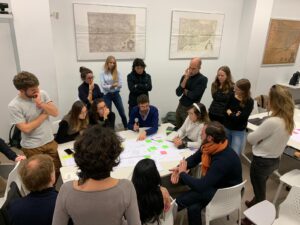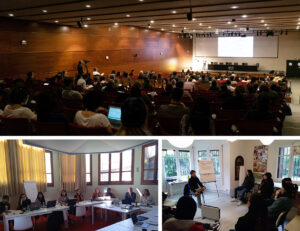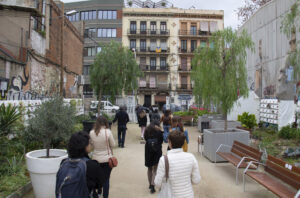These are challenging days. The COVID19 pandemic is revealing to us the vulnerabilities of our socio-economic systems. We are living under exceptional circumstances different national lock-downs, and questioning our way of living, moving, working, socializing, while looking out of our windows how few big players are becoming even bigger, and vulnerable people are suffering the worst consequences of all of this.
As the Director of this Master program, and having the honor of chairing the Urban Resilience Research Network, I’m writing some food for thoughts I think worth sharing. I would not like to incur the risk of getting on the pulpit and tell you how to interpret what is happening, as we are already flooded with webinars, scientific papers, videos and experts telling us what happening (coming to sometimes pointless conclusions on something that is just started). I would like, instead, to share some reflections on how we work, teach and learn from each other, and thus why this could be not only much needed nowadays, but also defined as “pandemic-proof” learning.
From one side, I’d like to respond here to the many applicants asking us if this is a good moment to get involved in our courses, and by the other hand, I would like to explicit my point of view on how particularly right feels this very moment to challenge (and change) most of current higher education programs, toward a more “Trans-disciplinary education model”, based on “active and continuous learning” and the creation of “communities of practice”.
It seems I’m just using a lot of fuzzy catchwords. But let me go through them, very quickly, to at least try to declare an intention that I hope could be of inspiration.
Avoid old-school passive learning teaching: better to learn through a community of practice

When anybody starts working on urban resilience, or sustainability, there is just too much to look at, too many good reports, papers, events debating and showing you what to think and how to tackle those wicked problems from different perspectives. Furthermore, most of these resources are just for free! Why to pay then, and choose to be sitting in a class, listening to just few experts (this is defined as “passive learning”), teaching to you from their personal point of view and experience?
In defense of the professors’ category, a good one will probably spend much more effort in making critical questions rising wildly in your minds, make you work through real case studies (this is defined “active learning”), rather than giving you packages of notions you could be reading and learning through the above-mentioned resources. But still, a bunch of good professors is a limited sample of the overall community, and you are still listening to few, limited points of view and experiences.
From another point of view, if you wish to skip learning from few professors, and study by yourself through the above mentioned resources, the plan is not that much better: each week there are more scientific papers and reports published (only on urban resilience) than a persona capacity to read them. So, what to read which could truly contribute to your learning path?
My experience for overcoming these limitations taught me that the opportunity to discuss, in depth, from time to time but in a continuous manner, with a colleague from a different field, and count with his/her support when needed, made me learn much more, and frame definitely more interesting researches and approaches to projects than trying to study or do it by myself. The old-fashion approach of schools’ teaching you to compete, rather than collaborate, with others and become the best student, the best expert, by knowing more than others… does not work nowadays addressing complex issues. Nobody works better than a group of experts knowing how to work together complementing each-others.
Well, this paradigm shift path from “knowing as much as I could” to “collaborate as widely as I could” is the guarantee of success for a learning path, and has been the philosophy guiding the creation and development of the Urban Resilience research Network. When myself (a planner interested in coastal climate resilience), met Marta Olazabal (an environmental engineering interested in urban energy transitions and redevelopment), Lily Yumagulova (emergency management background working on disaster risk reduction) and James Waters (dealing with ecosystem services and urban poor in Africa) and started to debate about urban resilience through our different approaches, that was so enriching! And a year after we were organizing an international workshop with other 8 colleagues from different fields, and the year after we were a group of dozens of scholars creating a blog to frame more collaborations, and now we are a group of more than 400 members sprawled around the globe, able to contribute to the framing of urban resilience research agenda, and having a say on implementation too, since consulting and working with most of the foundations, multilateral organizations and many cities.
This learning experience made clear to me that if you wish to deeply explore something complex, and be able to offer guidance, the best way of doing it is through a community of practice, and a continuous learning process. If you think about it, even the well-known Rockefeller 100 Resilient Cities program, after 6 years of working hand in hand with cities, evolved into a network called Global Resilient Cities Network (as we recently explained in details in one of our post here, resuming the seminar held by one of the 100RC directors). They thought a community of practice of City Resilience Officers was the best way cities could learn from each other and advance in urban resilience implementation. So why you should just sit in class learning from few professors and fighting with others students to have the best grades individually?

However, here we are called to offer a year of MSc Degree, not a learning journey throughout our network. What is then the point of my nostalgic and maybe also a bit self-congratulating discourse?
Well, the one-year master’s degree in city Resilience Design and Management is already designed as a way of getting introduced to an actual community of practice. Attendees are not just listening to professors, but exposed to active learning through case studies analysis, group works, in touch with city practitioners’ points of view, consultants and activists. Suddenly, students realize that the more you advance in the field of urban resilience, the more you are aware of all the things you still don’t know (and cannot learn in one year). Thus, working through our ALUMNI community is indeed the relevant part of the long-term learning journey – although it runs apart from the formal “lecture” time. Every student, then alumni, is admitted in a LinkedIn private group in which every week we crowdsource and share news and comments about urban resilience, every student is contributing to support publish here in the web the posts synthetizing our classes discussions, sharing jobs opportunities, and last but not least have access to all the future classes and seminars (which at least the 50% are new, year after year).
From Multi to Trans-disciplinary approaches in higher education
Dealing with water purification systems, however, is paradoxically much easier than dealing with urban resilience and sustainability complex disciplinary realm. Not by chance, “a multidisciplinary approach” was the title of the first book released in 2012 from the URNet. A step further was taken, when we started combining our perspectives to collaborate in the same project, through an integrated framework, and thus taking it a step further, toward an “Inter-disciplinary approach”. Here, interesting things happened, as launching the “resilience trade-off” concept. We broadened our analytical methods, scope and understanding of the (complex, adaptive) reality. However, when you wish to leave behind your discipline, and understand how things in the real world work, you need to enter the “transdisciplinary” field – meaning you move across disciplines and engage directly with other source of knowledge outside the academia. This is called “action-based research”: aiming to tackle societal challenges. Here is were you work on real world case studies, focusing on an urban problem explored with the help of experts, professors, city practitioners, indigenous communities, trying to gather and use the collective knowledge to propose and co-design a sustainable and resilient set of solutions.

Along the 1 year of MSc with us, we transit from a Multi-disciplinary approach (first months, with different experts from a variety of disciplinary background in resilience) to Interdisciplinarity (introducing tools for integrated urban resilience assessments), and finally entering the Trans-disciplinary approaches, working in teams in partnership with city practitioners on real world problems through the workshop.
Every year, we select the small group of students as composed by different backgrounds, age and country of provenience, leveraging exactly on the built-in diversity of the group to co-learn and co-create learning paths through virtual and in person classes, individual study and researches, group exercises, crowdsourcing and debates. We expect every attendee to be an active part of a community able to work in a transdisciplinary way, with a global perspective and an ethical responsibility in addressing and contributing to spread the learning on resilience for urban sustainable futures.
A “pandemic-proof” learning method?
Well, it took more than 1.500 words to get you here, and at this point you should be able to draw your own conclusions about this question. This is how we intend to work and learn, and why.
The fact that unexpected locks-down forced most of the universities classes to go suddenly online, resulted sometimes in students being 4, 5 or more hours a day narcotized in front of a screen because of the passive learning method most of the courses adopt.
Luckily, our model is not based on passive learning, and was already relying on a mix of methods. But is ours a “pandemic proof” learning model? To me, there is no such a thing. We need to interact with each other bodies, to get our hands dirty in the working sites, while of course using all the opportunities offered by the web and digitalization. The fact that this is the first stage for becoming part of a community of practices, could be indeed seen as something pandemic proof. Now more than ever, because of the pandemic crisis, the discussions and jobs and windows of opportunities for contributing to adapt, recovery and establishing “new normal” for our cities are greater now than ever. So back to our first question rose from many applicants, about whether now, during a pandemic, is it worth to study resilience, or whether to postpone their attendance, the easy answer is that… yes guys, NOW is the moment! While for other courses a pandemic could be a treat, to us is the (luckily or not) perfect stage for testing, learning and implementing resilience.
However, beyond a “pandemic-proof” educational model, what I tried to synthetize here, is that the present and future of real learning stands within a community of practice, embedded in continuous and active learning processes through transdisciplinary approaches. This is how you could individually and professionally further expand your skill-set in response to a complex-adaptive global environment, that changes unpredictably, and which requires adaptive capacities and a strong network of collaborators to always support and complement each other on how to cope with such uncertain, exciting today.
